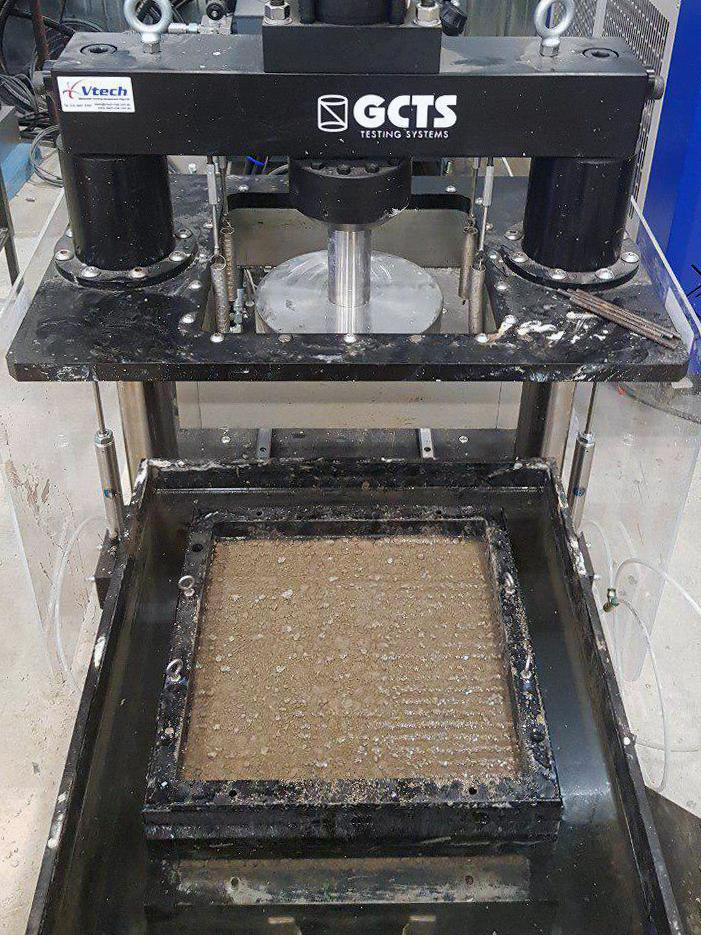Jul 30 2020
Scientists have demonstrated that a combination of building rubble and old tires could be utilized as a sustainable material for making roads, offering a zero-waste solution to support the circular economy and increase recycling.
 Researchers used special machinery to assess how the recycled material performed under frictional force, replicating the pressures of being driven over by countless vehicles. Image Credit: RMIT University.
Researchers used special machinery to assess how the recycled material performed under frictional force, replicating the pressures of being driven over by countless vehicles. Image Credit: RMIT University.
Demolition, renovation, and construction account for around 50% of the waste generated every year across the world, while about 1 billion scrap tires are produced every year worldwide.
Created by the research team from RMIT University based in Melbourne, Australia, the new material is the first of its kind to integrate recycled rubble and rubber in a mix that is accurately improved to fulfill road engineering safety standards.
The recycled blend, which has been developed to be used for base layers, is more flexible when compared to regular materials, rendering roads less prone to cracking.
According to lead researcher Dr Mohammad Boroujeni, the rubble-rubber blend could deliver engineering as well as environmental benefits.
Traditional road bases are made of unsustainable virgin materials—quarried rock and natural sand. Our blended material is a 100% recycled alternative that offers a new way to reuse tire and building waste, while performing strongly on key criteria like flexibility, strength and permanent deformation.
Dr Mohammad Boroujeni, Lead Researcher, RMIT University
Dr Boroujeni continued, “As we push towards a circular economy that can eliminate waste and support the continual use of resources, our recycled blend is the right choice for better roads and a better environment.”
Just 16% of scrap tires are domestically recycled in Australia. Every year, around 3.15 million tons of processed building rubble, called recycled concrete aggregate (RCA), is added to stockpiles instead of being reused.
Back in 2019, both state and federal governments decided to prohibit the export of specific waste materials, with the goal of building Australia’s capacity to produce high-value recycled commodities and meet the related demand. As part of the 2019 agreement, whole used tires will not be exported from December 2021.
On the Road to a Circular Economy
Roads are composed of four layers—that is, a subgrade, base, and sub-base, followed by asphalt on top. All the four layers should be robust enough to resist the pressures of heavy vehicles and, at the same time, they should be sufficiently flexible to enable the correct amount of movement, so that a road does not crack easily.
While RCA could be utilized on its own for road base layers, adding recycled rubber can considerably improve the end product.
In earlier studies, the researchers from RMIT School of Engineering had demonstrated that their rubble-rubber mix performed well when tested for deformation, stress, strength, dynamic properties, as well as water and acid resistance. Its excellent flexibility and low shrinkage decreased the risk of cracking.
Published in the Construction and Building Materials journal, the new study observed how the blend would resist the pressures of being driven over by an unlimited number of vehicles across its lifespan.
Scientists utilized unique machinery to evaluate the performance of the blended material under shear stress, or frictional force, and then compared different kinds of crumb rubber (coarse and fine) blended into the RCA at varying ratios.
The researchers eventually identified an optimal mixture—that is, 0.5% fine crumb rubber to 99.5% RCA—that not only delivered shear strength but also maintained excellent cohesion between both materials.
According to Jie Li, Chief Investigator and Professor, while the recycling of scrap tires and construction waste was increasing, both sectors continued to generate considerably more waste than is presently reused.
Solutions to our waste problems will come not only from reducing how much goes to landfill and increasing how much we recycle; developing new and innovative uses for our recycled materials is absolutely vital.
Jie Li, Chief Investigator and Professor, RMIT University
Journal Reference:
Saberian, M., et al. (2020) An experimental study on the shear behavior of recycled concrete aggregate incorporating recycled tyre waste. Construction and Building Materials. doi.org/10.1016/j.conbuildmat.2020.120266.